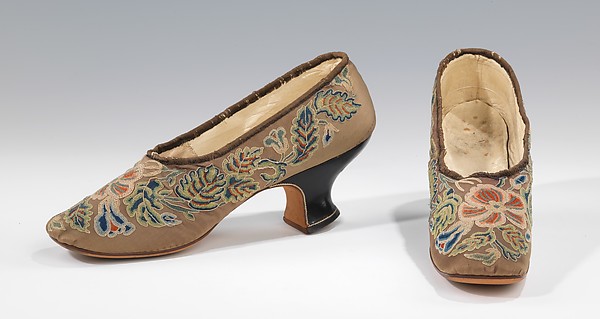I'm still plugging away on my 2012 "Vintage 365" project, ha! I want to share my new costume-related New Years Resolution with you, but I can't until I'm done with last year's.
Today I want to look at shoes of the 1860s through the 1880s. This is an interesting period in women's footwear because it marks the return-in-force of the high heel, and is another stretch of time in which women's shoes didn't really change all that much.
We're looking at just slippers today, dainty little pumps worn for both day and evening:
 |
| The Met: Shoes, 1860-79, leather |
 |
| The Met: Slippers, Evening, 1855-65, silk |
 |
| ebay, 1880 (via) |
You will see the majority of slippers from this period in white, because we have a disproportionate number of wedding shoes in museum collections. Wedding slippers were made of satin, and also a very fine, lightweight kid leather or doeskin leather.
 |
| 1860-70 from Shoe Icons. |
 |
| 1870-80 silk evening pump with beaded embroidery, from Shoe Icons |
 |
| The Met: Shoes, 1867, leather, silver, cotton |
Shoes of this period were quite colorful, however, when they weren't wedding shoes. Unlike footwear of the previous decades, shoes began to play a more important role in fashion as skirts slimmed from large hoops to bustles, like to reveal at least the toes of a lady's shoes, if not a glimpse of the whole foot. Sequins, embroideries, mock-Georgian buckles and ribbons, and bow ties were all popular to wear on the toes of one's shoes.
 |
| Met: shoes, 1870s |
 |
| The Met: Shoes (Pumps), 1860s, French, leather |
 |
| The Met: Slippers, 1885 - you can see the heel shape begin to transition between the earlier, shorter, kidney or opera heel shape into the French heel shape that would reign from the 1890s to the 1920s. |
From the late 1850s to the 1880s, most slippers featured the same hallmarks. These were:
- A square toe
- A short kidney or French heel, sometimes knock-on
- Side seams
- Almost always decoration of some type on the toe
The closer to the 1890s we get, the higher the heels, and pointier the toes.
 |
| The Met: Slippers, Evening L. Perchellet (French) Date: 1890–99 - compare these to the examples above - we still have side seams and decorations on the toes, but the heel and toe shapes are completely different. |
So remember, my beauties, if it has a square toe and a short heel, it most likely dates from the late 1850s to the 1880s!









